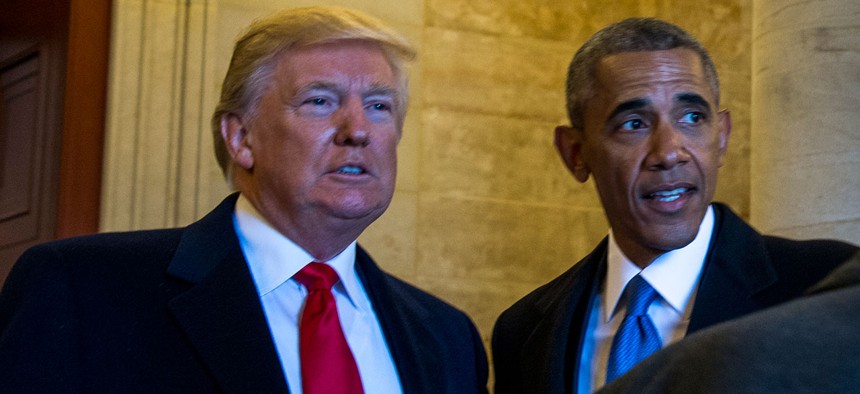
Staff Sgt. Marianique Santos/Defense Department
Can You Tell the Difference Between the Trump and Obama Management Agendas?
See how you do on this pop quiz.
Improving government management is one of the few remaining bipartisan endeavors in Washington. Whether a Democrat or a Republican is in the White House, the key tenets of recent management reform efforts tend to be similar, from overhauling the federal civil service to modernizing government’s information technology systems.
In fact, it can be difficult to tell presidential management initiatives apart from administration to administration, even when the party in power changes. Take the current president and his immediate predecessor. Can you tell the difference between the Trump and Obama management agendas?
Below are some key quotations and excerpts from important documents related to government reform efforts. See if you can tell which were generated by the Trump administration and which date from the Obama years. Answers are at the bottom.
1. Title of key document
a. Delivering Government Solutions in the 21st Century
b. Creating a 21st Century Government
2. In the president’s words
a. “I also asked Congress for the authority to reorganize and consolidate the federal bureaucracy. We’re doing a lot of this work administratively, but unfortunately there are still a bunch of rules, a lot of legislation that has poorly designed some of our agencies and forces folks to engage in bureaucratic jump-hoop -- hoop jumping instead of just going ahead and focusing on mission and delivering good service to our citizens.”
b. “At all levels of government, our public servants put our country and our people first. The hard work of our mail carriers, teachers, firefighters, transit workers, and many more, creates an environment that allows individuals and companies to thrive.”
3. Introduction to proposal
a. “The public still believes that the federal government serves critical roles, and in some areas performs them well. However, public trust in the federal government has declined over the last decade, calling into question how well the current organizational constructs of government are aligned to meet Americans’ needs in the digital age.”
b. “The President’s Management Agenda [is] a comprehensive and forward-looking plan to deliver better, faster, and smarter services to citizens and businesses; increase quality and value in the government’s core administrative functions and continue efforts to enhance productivity and achieve cost savings across the government…”
4. On federal real estate
a. “There are opportunities for savings by using federal space more efficiently and disposing of unneeded space, and the president has made it a priority to shrink and reduce the cost of operating the federal real estate inventory.”
b. “[We will] optimize the federal real property footprint by making smart investments in renovations and new facilities, driving down lease costs, and disposing of unneeded real estate through a streamlined process that results in the greatest return to the taxpayer.”
5. On government data
a. “The use of data is transforming society, business, and the economy. If the federal government does not maintain its role as a preeminent supplier and sophisticated user of data it will no longer be able to fulfill the trust placed in it by the American people.”
b. “The administration supports efforts to unlock federal data sets with a high potential for economic impact, including in the areas of health care, energy, education, public safety, tourism, and agriculture.”
6. On the federal workforce
a. “Federal employees underpin nearly all the operations of the government, ensuring the smooth functioning of our democracy. While most Americans will never meet the president or even their members of Congress, they will interact with the federal employees who work in their community, keep them safe at airports, or welcome them to a national park.”
b. “To fully capitalize on the talents in today’s workforce at all levels, and recruit and develop the capabilities needed for the future, the administration is committed to undertaking executive actions that will attract and retain the best talent in the federal workforce and foster a culture of excellence.”
7. On customer experience
a. “Government must build, buy, and deliver services that meet the expectations of a 21st century society, taking into account the rapid pace of innovation and user experience to which American citizens and businesses are accustomed.”
b. “Americans expect well-designed, efficient government services that are generally comparable in quality to that of leading private-sector organizations. Unfortunately, customer satisfaction with federal services lags behind every other industry…”
8. On shared services
a. "Today, many agencies are spending too much time and money on administrative and operating functions that are not central to their core mission and shared by other agencies.”
b. “Businesses, non-profits, and state governments have reduced costs and workload by streamlining administrative activities such as human resource transactions, financial management, grants management, contracts, and information technology support to reduce costs and increase efficiency. The federal government needs to do the same.”
Answers:
1. a. Trump b. Obama
2. a. Obama b. Trump
3. a. Trump b. Obama
4. a. Obama b. Trump
5. a. Trump b. Obama
6. a. Trump b. Obama
7. a. Obama b. Trump
8. a. Obama b. Trump
Sources:







